Making Butter
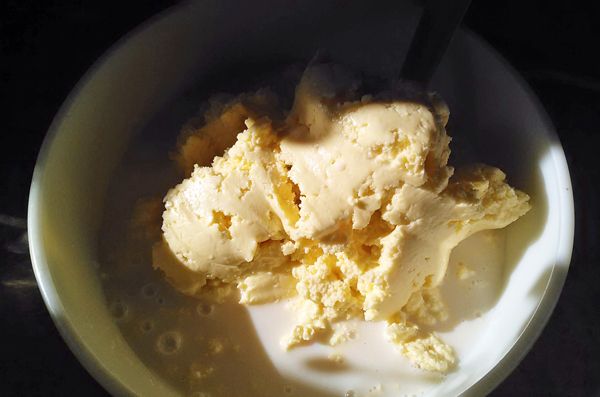
Our raw milk dairy, Sidehill Farm in Hawley, MA starting offering ½ gallons of cream for sale in 2016.
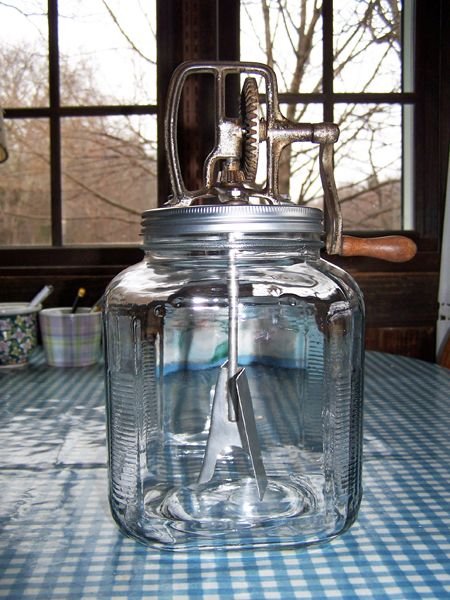
A few years back, I had found the lid and dasher to a good size butter churn at a tag sale for $7. I got this jar from BuyNothing and my husband mounted the works on the lid that came with the jar. I've saved the old lid as it carries all the ID for the churn.
This is a Lightning Butter Machine patented on February 6, 1917 and originally manufactured by the Stewart-Skinner Company of Worcester, Massachusetts. They sold for $1.50, $2.00, $2.50 and $3.00 for the 1, 2, 3 and 4 quart sizes. The Stewart-Skinner Company sold its butter churn business around 1923 and these butter churns were then manufactured by the Reynolds-Brown Company of Beverly, Massachusetts. Eventually the Taylor Manufacturing Company of Wollaston, Massachusetts acquired the business.
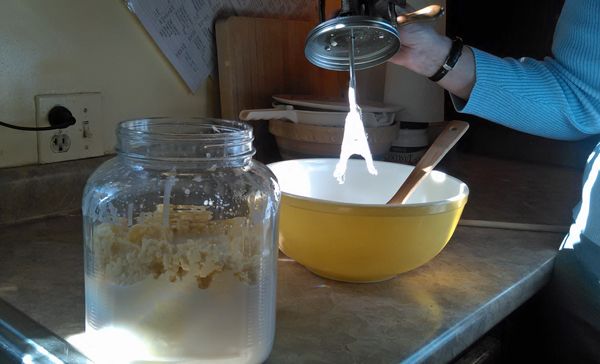
In March 2016, we made our first butter. This was not the optimal time to be making butter, but we were just experimenting to see how it worked.
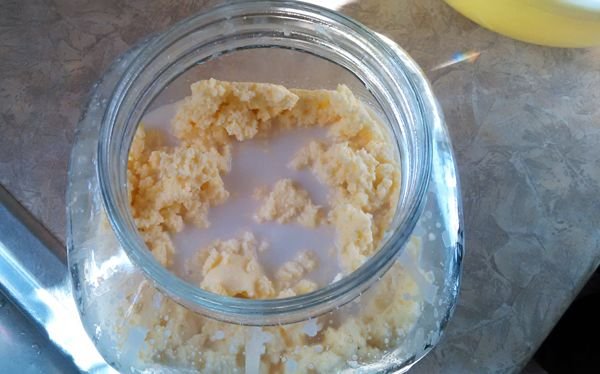
Look at the color of the butter, even in March!
Ideally, butter should be made from cream produced just as the cows start on pasture in the spring. The cream is best until the grass starts to go to seed in June. So we decided to wait until early May before making any more.
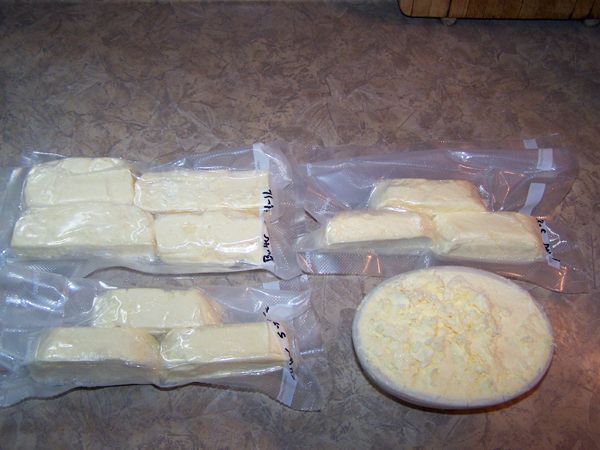
The end of May 2016, not quite 1/2 gallon of Sidehill cream made all this butter this week.
I didn’t keep weight records of what we made in 2016, but it lasted until mid May 2017.
We started making butter on May 5, 2017 and made it every week until August 11. The weight total for 2017 was 76 lbs 12 oz. The best day we had was June 23 when we got 10 lbs. 8 oz. from 2 gallons of cream.
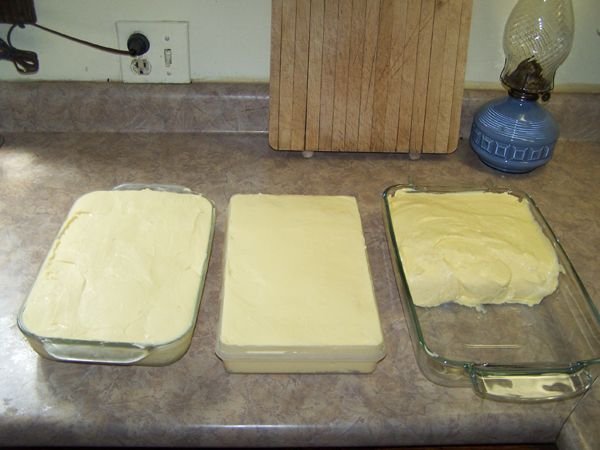
The reason we spent so long making butter was that we didn’t know we could order gallons of cream ahead. We just took what was there each week. This year we will be ordering 2 gallons each week during May and June and hope to finish by the first of July.
What We Learned About Making Butter
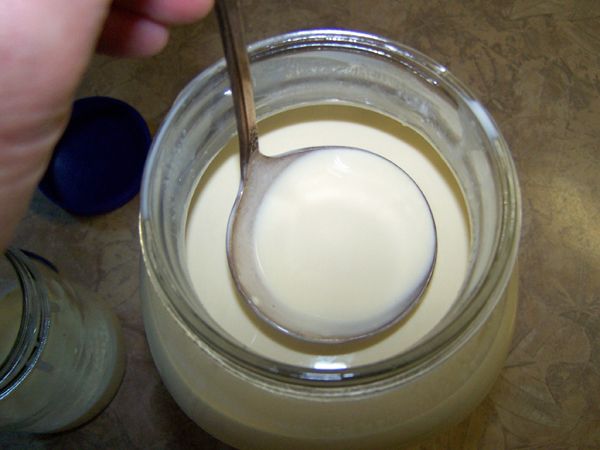
My cream has been mechanically separated at the farm. If you are dipping your cream, try to not get any milk into it. Allow the milk to stand at least 24 hrs, longer is better, to let the cream rise.
My fridge is kept at 39F as foods last longer when colder. It takes a long time for cream to warm up. We found the best butter came from cream at 63F. So when I got up around 5AM, I would decant the gallons of cream into ½ gallon glass jars and set them in my gas oven with the pilot light. By the time we were ready to make butter at 8:30 they would be just about the right temperature.
When you crank the cream in the jar it eventually swells up. If you’ve filled it too full, it comes out the top around the shaft. We found the optimal level was where the lines ended on the jar corners (look at the photo closely, above).
We found that a steady, but not fast, rhythm of cranking produced the best butter. Faster speeds tended break it up instead of having it clump together. At 63F the butter would come between 7 – 15 mins. As I said the cream swells and then slowly starts to recede. When this happens slowing the speed will encourage the butter to clump together. You can see this in the video.
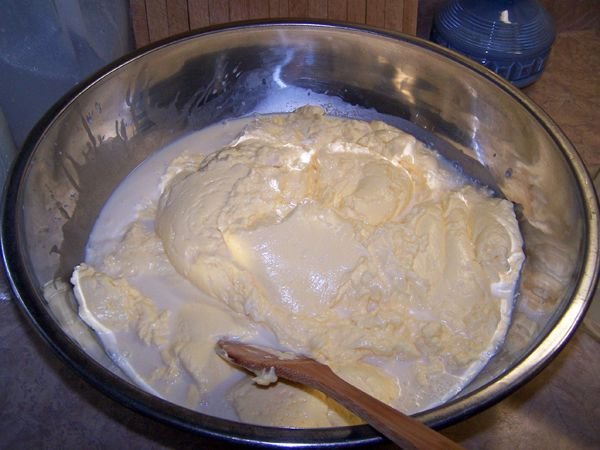
Remove the dasher and clean it off into a large sturdy bowl. Pour off as much of the buttermilk as you can into a separate bowl, then put the butter into the sturdy bowl.
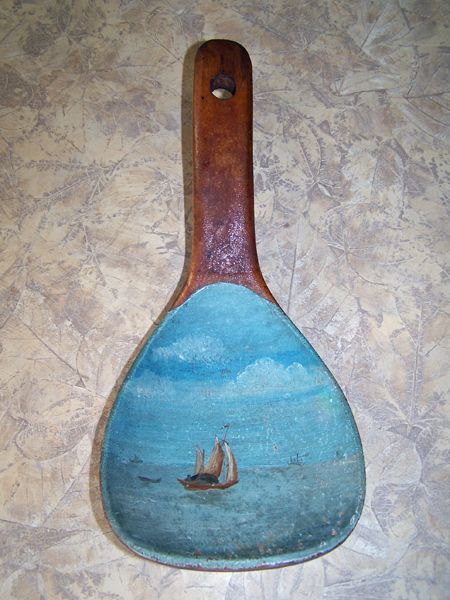
My great, great, great grandmother Martha Washington Dewolf Briggs’ butter paddle circa 1850’s
Pressing with a butter paddle or a sturdy tool that will fit the slope of the bowl helps remove the buttermilk from the butter. When you’ve pressed out as much as you can and saved it for use, it’s time to start washing the butter.
In the beginning use cool, not quite temped water, not warm. You want the butter to remain firm enough that when you pour off each washing, the butter doesn’t flow out of the bowl too. But if it gets too firm, it’s just hard work to press it. You want enough water so you can submerge each scraping, but not so it slops around.
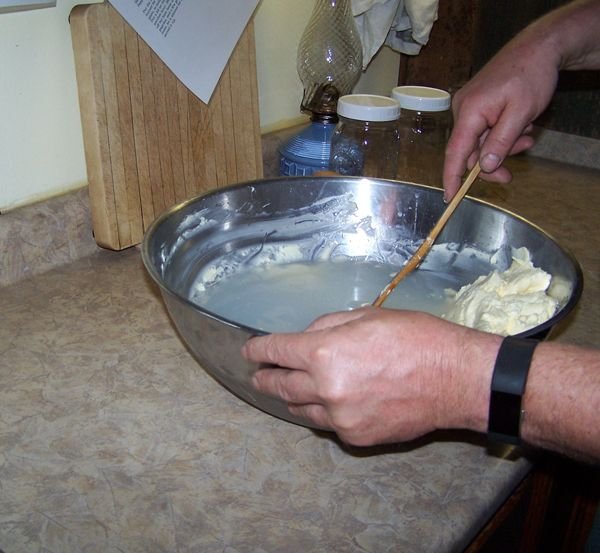
You should do a minimum of 12 washings. Place the butter on one side of the bowl, scrape off a small amount and press it through the water, under the water, to the other side. Do this until it’s all on the new side. Dump the water (it’s good for pigs) into a bucket and start again.
Along about washing #9, you will want to start using cold water to firm the butter up for handling. By washing #12 the water should be clear. If it is not, keep going until it is.
Any buttermilk left in the butter will cause it to turn and have a bad taste pretty quickly, even if refrigerated.
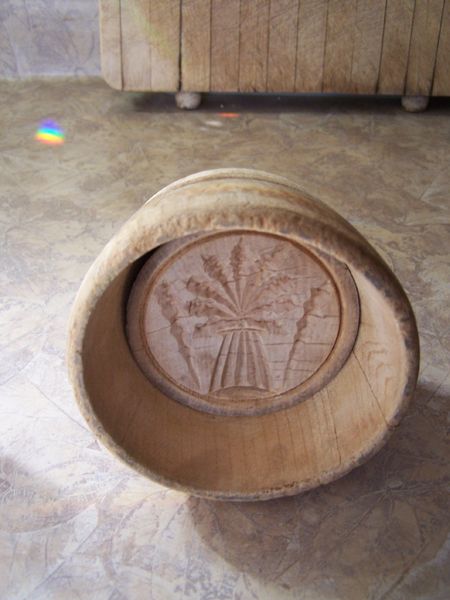
Press all water out of the butter, by scraping it to the other side of the bowl, draining off the water as you go. Once this is done, you can add salt and work it in. I do not salt my butter, so I can’t say how much to add. I’ve seen ½ teaspoon per pound of butter as a suggestion.
If you have a butter mold, wet it thoroughly so the butter won’t stick and press the butter into it.
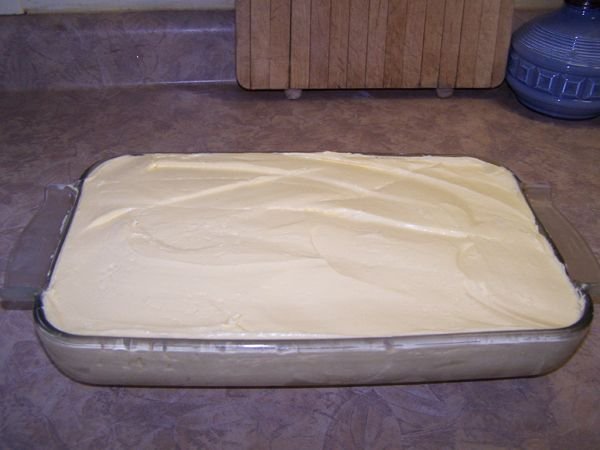
This is about 6 lbs.
I just press it into glass baking pans, smooth the top and put it in the fridge to firm up. In a few hours I loosen it in the pan by running under hot water, then I cut it in roughly ¼ lb size pieces, wrap it in plastic wrap, vacuum seal 4 per package, weigh, label and date, and freeze.
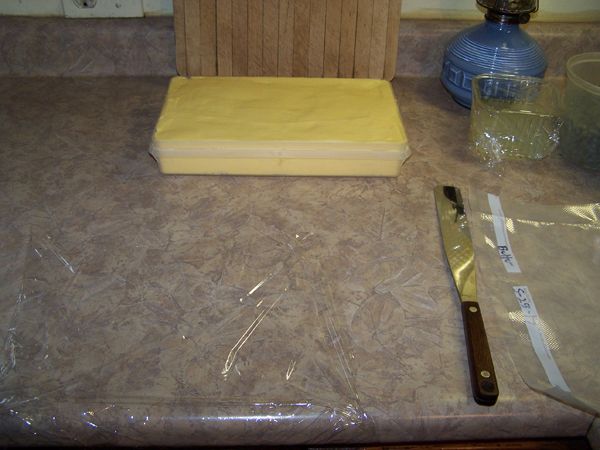
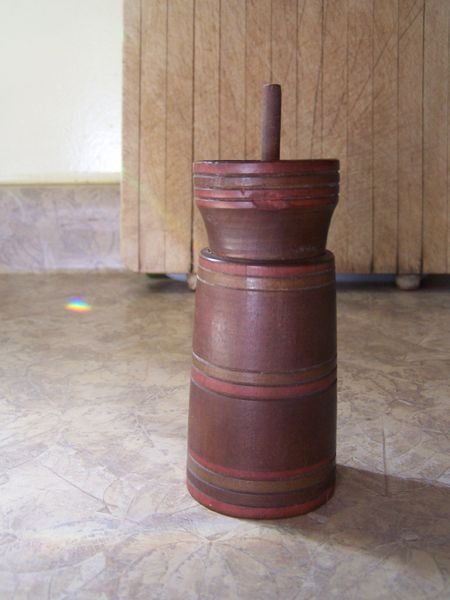
My great great grandfather, John Lewis Raymond made this toy butter churn.
I don't have a dairy cow, but I feel fortunate to live close to a dairy, Marley's Creamery, where I can buy raw milk. We make butter with cream, and it is so much different than store bought butter! But what I really love is the butter milk. It's a totally different creature than what is found on store shelves. 😁
We were amazed at the flavor of that first batch of butter. This farm is using nutrient density practices and it really shows in the milk and cream. The color is incredible.
WOW my friends make butter from goats milk and whipped cream too! Lol I do not have to make a thing. I bring them the herbs they need and in turn, I get butter, milk and other awesome stuff... Package going out!
I'm bartering butter for a T5 light stand. And....package went out!
What is a t5 light stand?
If you look above and to the left of the ginger, you can see 1/2 of it. It's 4' long, and this one has a single T5 bulb in the fixture.
Most of the lights you see in my photos are the old T12 bulb fixtures, think standard florescent tubes.
But that last stand we built, the big one, was for 4 lamp T5 bulb fixtures.
Can’t beat this for taste! Homemade bread, hot and some fresh butter...wow!
My oh my that butter looks beautiful. I'm pretty much green with envy over here! I can't get my hands on unhomogenized milk, let alone raw. I could buy heavy cream but it always has additives and costs much more then buying butter.
Any who, beautiful post and product ♡
This is NOT cheaper than buying butter. I am making nutrition with raw cream butter. And it's far more expensive. I long ago learned cheap food is paid for steeply later in life.
Oh I didn't say what you're doing is cheaper, I said its cheaper for me to buy butter that's just cream and salt than for me to make butter from store bought pasturized additive filled cream, which is my only option if I want to make butter myself. I would pay 5x what I do if I could get my hands on raw milk and cream, I am very aware of the nutritional benefits :)
In Canada unless you have your own animal you are out of luck. Its illegal for raw milk to leave a farm and very heavily fined and controlled by the government.
Oh! I didn't think you'd said mine was cheaper, but I didn't realize raw milk/cream is not available in Canada. That's the pits it's so heavily controlled. :(
I know its so sad. I almost had a lead on a farmer willing to break the rules but it fell through.
Maybe one day the gov will lighten up and I'll get to make some beautiful butter like you.
Until then I will drool over posts like this!
Take care ♡
This brings back so many memories. Way back when I was a kid around 6 years old we made our own whipping cream and butter from cow and goat milk. Our churn jar got smashed so we just filled large mouthed quart jars about 3/4 full of cream or milk. Capped it with a bit of plastic bag and a jar ring -then shook the death out of each jar. (usually 2 or 3 at a time, one for me, one for my brother, and one for dad)
We did try shaking but it was too hard on us. So we looked and looked and found a jar that would fit the dasher. So much easier!
This is incredible! Love the detail!
Sweet tasting butter is all about the details! So I put them in so everyone's first butter making tastes wonderful!
Do you make it just for your family, or do you sell it?
We make it just for our family as it's illegal to sell raw milk anything off the farm it was produced on, here in Mass. And just in case you were wondering, it costs nearly $15/lb to make (that includes labor). But you can not buy the quality of butter that I am making. For starters, it would be from pasteurized cream. That kills most of the nutrition right there.
Yes here in FL it is illegal to sell raw milk also.
Very interesting article. We have been looking at making our own butter once we get a few more things knocked out first. What type of cows is your butter being produced from? I have not made butter before but I am curious about this. " butter should be made from cream produced just as the cows start on pasture in the spring. The cream is best until the grass starts to go to seed in June"? What is the purpose of this?
The cows our cream comes from are Normandy and Jersey.
The composition of the cream changes when the composition of the grass changes. The early flush grass has a better profile for butter. Once that grass changes and starts to produce seed the composition changes. You can still make butter, but the composition favors cheese making at this point.
Thank you for that.
Congratulations! This post has been added to our growing directory of Steemit "how to" posts for the Homesteading/Survival/Foraging/Prepper communities. If you haven't done so already, you can claim your badge along with the code to add to your posts to let the world know you have chosen to help others Survive, Thrive and be Prepared! Click here to get the code